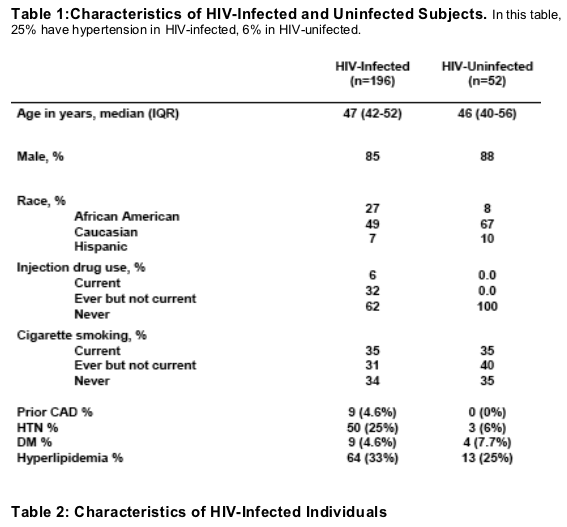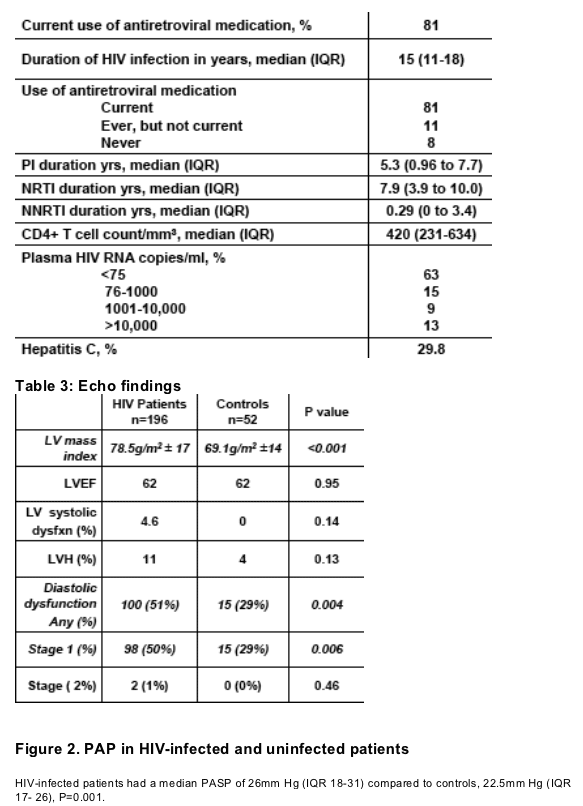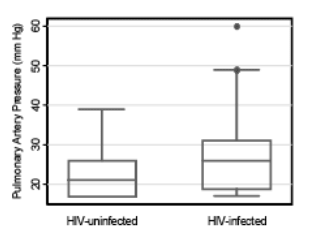 |
 |
 |
| |
Diastolic Dysfunction is Common in Asymptomatic HIV Patients
|
| |
| |
Reported by Jules Levin
15th CROI, Feb 2008, Boston
Priscilla Y. Hsue1,2, Husam H. Farah1,2, Ann F. Bolger1,2, Swapna Palav2, Samira Ahmed2, Amanda Schnell1,2, Steven G. Deeks1,2, Jeffrey N. Martin1, and David D. Waters1,2
1University of California, San Francisco, 2San Francisco General Hospital
AUTHOR CONCLUSIONS
Asymptomatic HIV patients had a higher prevalence of cardiac abnormalities, namely increased LV mass, diastolic dysfunction, and mildly elevated PASP, compared to uninfected controls. HIV infection was independently associated with all of these findings. Future studies are needed to determine the etiology and natural history of these abnormalities in HIV-infected individuals.
Predictors of LV mass index:
In HIV patients and controls: After adjusting for DM, CAD, age, lipids, and cigarettes, HIV infection (P<0.001), male gender (P=0.001), and hypertension (P=0.022) were associated with higher LV mass index.
In HIV patients only: After adjustment for age, DM, CD4 count, HIV viral load, duration of HIV infection, and duration of PI use, male gender (P=0.012) and hypertension (P=0.022) were associated with higher LV mass index.
Predictors of diastolic dysfunction:
In HIV patients and controls: After adjustment for IVDU, DM, and prior CAD, HIV infection (P=0.027), LV ejection fraction (P=0.035), older age (P<0.001), and hypertension (P=0.023) were associated with diastolic dysfunction.
In HIV patients only: After adjustment for DM, ART, duration of HIV infection, and HIV viral load, age (P=0.001), LV ejection fraction (P=0.036), and hypertension (P=0.023) were associated with diastolic dysfunction.
Predictors of Pulmonary Artery Systolic Pressure:
After adjusting for age, gender, smoking, IVDU, and hypertension, HIV-infected subjects had a 4.0 fold greater odds (95% CI 1.3 to 12) of having PASP > 30mm Hg, P=0.016.
BACKGROUND
With the advent of antiretroviral therapy, HIV-infected individuals are living longer and developing chronic cardiovascular conditions. Among the less well characterized conditions are systolic and diastolic dysfunction. Prior echocardiographic studies in HIV patients were performed before the era of antiretroviral medications.1,2 Studies in HIV-infected children show that mild LV dysfunction and increased LV mass are common and are associated with increased mortality.3 A study of adult cocaine users with HIV found that protease inhibitors were associated with increased interventricular septal thickness and decreased E/A ratios (which are suggestive of LVH and diastolic dysfunction).4
PURPOSE
To determine the prevalence of systolic and diastolic dysfunction in a contemporary group of asymptomatic HIV patients
To determine predictors of systolic and diastolic dysfunction in HIV-infected individuals
METHODS
Patient selection - We studied HIV-infected adult enrolled in the Study of the Consequences of the Protease Inhibitor Era (SCOPE) cohort at San Francisco General Hospital. This cohort consists of 1) untreated patients, defined as no antiretroviral therapy in the preceeding 6 months, 2) treated patients with detectable viremia, defined as >24 weeks HAART with the most recent two HIV RNA levels >50 copies/mL, and 3) treated patients who achieved full viral suppression defined as >24 weeks HAART with two most recent HIV RNA levels <50 copies/mL.
Echocardiographic Studies - Echocardiography was performed on 196 HIV-infected adults and 52 uninfected controls. Left ventricular ejection fraction was assessed using the modified Simpsonfs rule. Left ventricular mass was indexed to body surface area. Diastolic dysfunction was assessed using mitral and pulmonary vein inflow patterns and doppler tissue imaging.5 Tricuspid regurgitation was assessed in the parasternal right ventricular inflow, parasternal shortaxis, and apical four-chamber views (Fig 1A). Three sequential complexes were recorded and measured. Continuous-wave Doppler of the peak regurgitant jet velocity was used to estimate the pressure gradient between the right ventricle and right atrium using the modified Bernoulli equation (Figure 1B). The right atrial pressure was assessed according to degree of collapse of the IVC.
Left ventricular hypertrophy (LVH) - Reference limits for LV mass/
BSA used: Women: 43-95 g/m2
Men: 49-115g/m2
Ejection Fraction:
2D method: ≥ 50%
RESULTS
The characteristics of the patients are shown in Tables 1 and 2. As shown in Table 3, the HIV patients had a higher LV mass index compared to controls.
More than half of the HIV patients had diastolic dysfunction - the majority of which was Stage 1 diastolic dysfunction.



References
1. Blanchard DG et al. Reversibility of cardiac abnormalities in human immunodeficiency virus (HIV)-infected individuals: a serial echocardiographic study. JACC 1991; 17: 1270-6.
2. Hecht SR et al. Unsuspected cardiac abnormalities in the acquired immune deficiency syndrome. An echocardiographic study. Chest 1989; 96: 805-8.
3. Fisher SD et al. Mild dilated cardiomyopathy and increased left ventricular mass predict mortality: the prospective P2C2 HIV Multicenter Study. Am Heart Journal 2005; 150: 439-47.
4. Meng Q et al. Use of HIV protease inhibitors is associated with left ventricular morphologic changes and diastolic dysfunction. J Acquir Immune Defic Syndr 2002; 30: 306-10.
5. Gaasch W and Little WC. Assessment of left ventricular diastolic function and recognition of diastolic heart failure. Circulation 2007; 116: 591-3.
|
| |
|
 |
 |
|
|